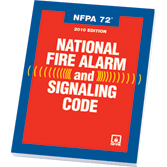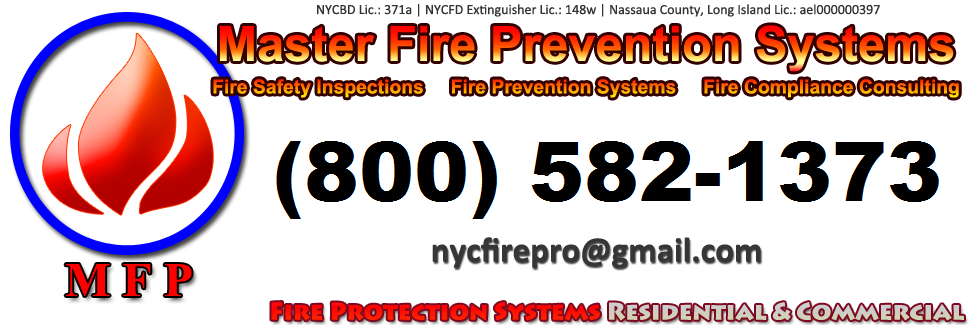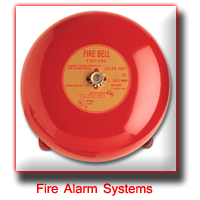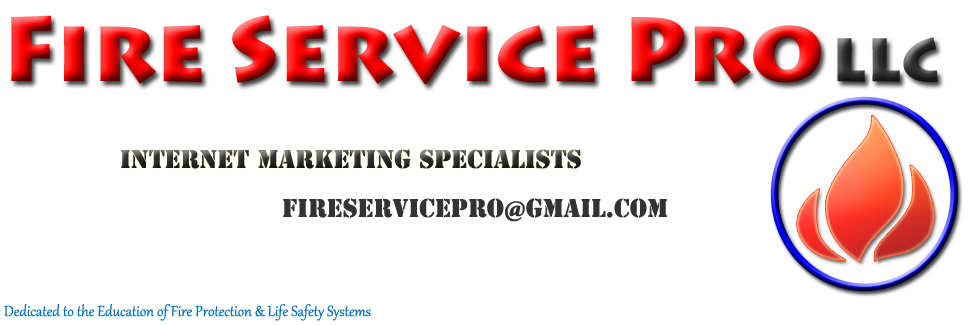
New York City NFPA 72 Fire Alarm Inspections, Tests and Maintenance
Residential, commercial and industrial fire protection systems may also be required by state, city and municipal health, building and fire codes to have all installed fire protection systems tested and inspected by local fire departments, state licensed fire protection companies, certified fire protection technicians and/or fire safety engineers. Keeping your fire alarm system operating and ready in case of an emergency.
Check with your local fire marshall, fire departments or city municipalities health, building and fire codes for details.
Visit NFPA 72: National Fire Alarm and Signaling Code to purchase most recent version. 
Table 10.4.3 - Testing Frequencies |
||||||
| COMPONENT | INITIAL/ REACCEPTANCE | MONTHLY | QUARTERLY | SEMI-ANNUALLY | ANNUALLY | |
| 1 | Control Equipment - Building systems connected to supervising station | |||||
| a) Functions | X | - | - | - | X | |
| b) Fuses | X | - | - | - | X | |
| c) Interfaced equipment | X | - | - | - | X | |
| d) Lamps and LEDs | X | - | - | - | X | |
| e) Primary (main) power supply | X | - | - | - | X | |
| f) Transponders | X | - | - | - | X | |
| 2 | Control equipment - Building systems not connected to supervising station | |||||
| a) Functions | - | - | X | - | - | |
| b) Fuses | - | - | X | - | - | |
| c) Interfaced equipment | - | - | X | - | - | |
| d) Lamps and LEDs | - | - | X | - | - | |
| e) Primary (main) power supply | - | - | X | - | - | |
| f) Transponders | - | - | X | - | - | |
| 3 | Engine-driven generator - Central station facilities and fire alarm systems | X | X | - | - | - |
| 4 | Engine-driven generator - Public fire alarm reporting systems | X (weekly) | - | - | - | - |
| COMPONENT | INITIAL/ REACCEPTANCE | MONTHLY | QUARTERLY | SEMI- ANNUALLY | ANNUALLY | |
| 5 | Batteries - Central station facilities | |||||
| a) Lead-acid type | ||||||
| 1. Charger test (replace battery as needed) | X | - | - | - | X | |
| 2. Discharge test (30 minutes) | X | X | - | - | - | |
| 3. Load voltage test | X | X | - | - | - | |
| 4. Specific gravity | X | - | - | X | - | |
| b) Nickel-cadmium type | ||||||
| 1. Charger test (replace battery as needed) | X | - | X | - | - | |
| 2. Discharge test (30 minutes) | X | - | - | - | X | |
| 3. Load voltage test | X | - | - | - | X | |
| c) Sealed lead-acid type | X | X | - | - | - | |
| 1. Charger test (replace battery within 5 years after manufacture or more frequently as needed) | - | X | X | - | - | |
| 2. Discharge test (30 minutes) | X | X | - | - | - | |
| 3. Load voltage test | X | X | - | - | - | |
| 6 | Batteries - Fire alarm systems | |||||
| a) Lead-acid type | ||||||
| 1. Charger test (replace battery as needed) | X | - | - | - | X | |
| 2. Discharge test (30 minutes) | X | - | - | X | - | |
| 3. Load voltage test | X | - | - | X | - | |
| 4. Specific gravity | X | - | - | X | - | |
| b) Nickel-cadmium type | ||||||
| 1. Charger test (replace battery as needed) | X | - | - | - | X | |
| 2. Discharge test (30 minutes) | X | - | - | - | X | |
| 3. Load voltage test | X | - | - | X | - | |
| c) Primary type (dry cell) | ||||||
| 1. Load voltage test | X | X | - | - | - | |
| d) Sealed lead-acid type | ||||||
| 1. Charger test (replace battery within 5 years after manufacture or more frequently as needed) | X | - | - | - | X | |
| 2. Discharge test (30 minutes) | X | - | - | - | X | |
| 3. Load voltage test | X | - | - | X | - | |
| 7 | Batteries - Public fire alarm reporting systems | X (daily) | - | - | - | - |
| (From street locations to the communications center) | ||||||
| a) Lead-acid type | ||||||
| 1. Charger test (replace battery as needed) | X | - | - | - | X | |
| 2. Discharge test (2 hours) | X | - | X | - | - | |
| 3. Load voltage test | X | - | X | - | - | |
| 4. Specific gravity | X | - | - | X | - | |
| b) Nickel-cadmium type | ||||||
| 1. Charger test (replace battery as needed) | X | - | - | - | X | |
| 2. Discharge test (2 hours) | X | - | - | - | X | |
| 3. Load voltage test | X | - | X | - | - | |
| COMPONENT | INITIAL/ REACCEPTANCE | MONTHLY | QUARTERLY | SEMI- ANNUALLY | ANNUALLY | |
| c) Sealed lead-acid type | ||||||
| 1. Charger test (replace battery within 5 years after manufacture or more frequently as needed) | X | - | - | - | X | |
| 2. Discharge test (2 hours) | X | - | - | - | X | |
| 3. Load voltage test | X | - | X | - | - | |
| 8 | Fiber-Optic Cable Power | X | - | - | - | X |
| 9 | Control Unit Trouble Signals | X | - | - | - | X |
| 10 | Conductors - Metallic | X | - | - | - | - |
| 11 | Conductors - Nonmetallic | X | - | - | - | - |
| 12 | Emergency Voice / Alarm Communications Equipment | X | - | - | - | X |
| 13 | Retransmission Equipment | X | - | - | - | - |
| 14 | Remote Annunciators | X | - | - | - | - |
| 15 | Initiating Devices | |||||
| a) Duct detectors | X | - | - | - | - | |
| b) Electromechanical releasing device | X | - | - | - | X | |
| c) Fire extinguishing system(s) or suppression system(s) switches | X | - | - | - | X | |
| d) Fire-gas and other detectors | X | - | - | - | X | |
| e) Heat detectors | X | - | - | - | X | |
| f) Fire alarm boxes | X | - | - | - | X | |
| g) Radiant energy fire detectors | X | - | - | X | - | |
| h) System smoke detectors - functional | X | - | - | - | X | |
| i) Smoke detectors - sensitivity | X - - - X | |||||
| j) Single and multiple-station smoke alarms | X | - | - | - | X | |
| k) Single and multiple-station heat alarms | X | - | - | - | X | |
| l) Supervisory signal devices (except valve tamper switches) | X | - | X | - | - | |
| m) Water flow devices | X | - | - | X | - | |
| n) Valve tamper switches | X | - | - | X | - | |
| 16 | Guard's tour equipment | X | - | - | - | X |
| 17 | Interface equipment | X | - | - | - | X |
| 18 | Special hazard equipment | X | - | - | - | X |
| 19 | Alarm notification appliances | |||||
| a) Audible devices | X | - | - | - | X | |
| b) Audible textual notification appliances | X | - | - | - | X | |
| c) Visible devices | X | - | - | - | X | |
| COMPONENT | INITIAL/ REACCEPTANCE | MONTHLY | QUARTERLY | SEMI- ANNUALLY | ANNUALLY | |
| 20 | Off-premises transmission equipment | X | - | X | - | - |
| 21 | Supervising station fire alarm systems - transmitters | |||||
| a) Digital alarm communicator transmitter (DACT) | X | - | - | - | X | |
| b) Digital alarm radio transmitter (DART) | X | - | - | - | X | |
| c) McCulloh transmitter | X | - | - | - | X | |
| d) Radio alarm transmitter (RAT) | X | - | - | - | X | |
| 22 | Special procedures | X | - | - | - | X |
| 23 | Supervising station fire alarm systems - receivers | |||||
| a) Digital alarm communicator receiver (DACR) | X | X | - | - | - | |
| b) Digital alarm radio receiver (DARR) | X | X | - | - | - | |
| c) McCulloh systems | X | X | - | - | - | |
| d) Two-way RF multiplex | X | X | - | - | - | |
| e) Radio alarm supervising station receiver (RASSR) | X | X | - | - | - | |
| f) Radio alarm repeater station receiver (RARSR) | X | X | - | - | - | |
| g) Private microwave | X | X | - | - | - | |
The inspection, testing and maintenance requirements that apply to your building’s fire alarm system start from the date of initial installation and continue on at specific intervals throughout the life of the system. What follows is a brief synopsis of some of the major requirements you need to be aware of.
New York City Fire Alarm Notifications : New York City Fire Alarm Tests, Inspections and Maintenance
In order to avoid unnecessary occupant response and potential injury to emergency response personnel, it is very important that all affected parties be notified prior to any scheduled testing of the fire alarm system [see NFPA 72(99), Sec. 7-1.3]. Those notified should include, but not be limited to, building occupants (e.g. visitors, staff and patients/residents) and the monitoring company or agency.
New York City Fire Alarm New Installations : New York City Fire Alarm Tests, Inspections and Maintenance
In order to meet both federal certification requirements and state licensure requirements, fire alarm systems are required to be installed in accordance with NFPA 72 and the requirements of NFPA 101 applicable to I-2 or healthcare occupancies NFPA 101(00), Sections 18/19.3.4 and 9.6.1.4]. All newly installed systems are required to be acceptance tested in accordance with the requirements of Chapter 7 of NFPA 72(99). Notify the fire code official prior to such testing.
New York City Fire Alarm System Modifications : New York City Fire Alarm Tests, Inspections and Maintenance
Reacceptance testing is required after any of the following occur [see NFPA 72(99), Sec. 7-1.6.2]:
- Addition or deletion of system components
- Any modification, repair or adjustment to system hardware or wiring
- Any change to site-specific software
- Notify the fire code official prior to such testing.
The extent of testing necessary is determined as follows:
- All components, circuits, system operations or site-specific software functions known to be affected by changes or modifications made to the system must be 100 percent tested.
- Ten (10) percent of initiating devices that are not directly affected, up to a maximum of 50 devices, must also be tested and proper operation verified.
- Whenever there are changes to control units connected or controlled by the system executive software, a 10 percent functional test of the system is required, including a test of at least one device on each input and output circuit to verify critical system functions such as notification appliances, control functions and off-premises reporting.
New York City Fire Alarm Semi Annual Tests & Inspections
New York City Fire Alarm Tests, Inspections and Maintenance
Certain fire alarm system components need to be visually inspected semiannually [see
NFPA 72(99), Table 7-3.1]. These visual inspections can be performed by facility staff and include:
- Control unit trouble signals – verify that they are readily visible
- Remote annunciators – verify that they are in proper operating condition and free of damage
- Initiating devices – verify that they are in place, unobstructed and free of damage to include:
- Manual fire alarm boxes
- Heat detectors
- Notification appliances – verify that they are unobstructed and free of damage
- Magnetic hold-open devices – verify that they are free of damage and function properly
- A visual inspection of fire alarm interconnect switches on kitchen hood extinguishing systems is also required.
- By exception, where a listed addressable fire alarm system is present that performs at least weekly automatic inspections of system components, the visual inspections are allowed to be conducted annually. The system would need to be capable of producing a print-out documenting these weekly inspections.
- Inspection and testing of batteries, smoke detectors (both hard-wired and battery-operated) and equipment used to transmit signals to a supervising station are covered later on in this guide.
New York City Fire Alarm Annual Tests & Inspections
New York City Fire Alarm Tests, Inspections and Maintenance
The entire system is required to be thoroughly inspected, tested and maintained each year by an approved servicing company in accordance with Chapter 7 of NFPA 72(99) [see NFPA 72(99), Tables 7-2.2, 7-3.1 and 7-3.2; NFPA 90A(99), Sec. 4-4.1]. Testing must include control equipment, remote annunciators, initiating devices, HVAC shutdown devices and alarm notification appliances.
Fire alarm interconnect switches on kitchen hood extinguishing systems are also required to be tested annually.
Inspection, testing and maintenance of batteries, smoke detectors (both system connected and battery-operated) and equipment used to transmit signals to a supervising station are covered later on in this guide.
New York City Fire Alarm Long Term Tests & Inspections
New York City Fire Alarm Tests, Inspections and Maintenance
Non restorable fixed-temperature, spot-type heat detectors are required to be replaced after 15 years from initial installation [see NFPA 72(99), Table 7-2.2, Item 13.d.3]. As an alternate, 2 detectors per 100 must be laboratory tested. If these detectors fail when tested, additional detectors must be tested to determine if the problem is a general or localized one.
- If detectors are tested instead of replaced, tests must be repeated at 5-year intervals.
- For rate-of-rise heat detectors and restorable fixed-temperature, spot-type heat detectors, 2 or more detectors must be tested on each initiating circuit annually [see NFPA 72(99), Sec. 7-3.2.3]. Different detectors must be tested each year, with records kept specifying which detectors were tested. Within 5 years, each detector must have been tested.
New York City Batteries
Batteries serving as a secondary power supply for fire alarm systems must be visually inspected at the following intervals to verify that they are free of damage* [see NFPA 72(99), Table 7-3.1, Item 3]:
- Lead-acid and primary (Dry Cell) batteries – monthly
- Nickel-Cadmium and sealed lead-acid batteries – semi annually
- You’ll also want to: check electrolyte (fluid) levels and tightness of connections; check for corrosion or leakage; and, if necessary, clean the terminals.
- Batteries serving as a secondary power supply for fire alarm systems must be tested semiannually, to include [see NFPA 72(99), Table 7-3.2, Item 6]:
- Load voltage tests on lead-acid, Nickel-Cadmium and sealed lead-acid type batteries
- Monthly load voltage tests are required on primary (Dry Cell) batteries
- 30-minute discharge tests on lead-acid type batteries
- Testing of specific gravity on lead-acid type batteries
- An annual charger test, conducted in accordance with NFPA 72(99), Table 7-2.2, Item 6, is required for lead-acid, Nickel-Cadmium and sealed lead-acid type batteries (this involves the use of a voltmeter or ampere meter) [see NFPA 72(99), Table 7-3.2, Item 6].
- Batteries must be replaced as needed, but typically last 3 years or more. Sealed lead-acid type batteries, however, are required to be replaced every 4 years.
New York City Smoke Detectors
Battery-operated detectors
Some facilities have had battery-operated smoke detectors installed to meet the federal certification requirements of NFPA 101(00), Sections 18/19.7.5.2 – requirements that apply to buildings that are either unsprinklered or only partially sprinklered.
- These detectors must be tested and maintained in accordance with manufacturer’s instructions. This means that:
- Detectors must be tested on a weekly or monthly basis as specified.
- Detectors must be cleaned monthly in accordance with manufacturer’s instructions [NOTE: Some manufacturers may recommend less frequent cleaning intervals].
- Batteries must be replaced annually or semiannually as specified by the manufacturer.
- Based on regulations published in the August 13, 2008 Federal Register, battery operated smoke detectors will no longer be required in long-term care facilities effective August 13, 2013, as all such facilities will then be required to be protected throughout by an approved, supervised automatic fire sprinkler system by that date [see 42 CFR Part 483.70(a)(8)].
New York City Hard-wired detectors
Hard-wired (including low voltage) automatic smoke detectors, including duct smoke detectors, must be visually inspected semiannually [see NFPA 72(99), Sec.7-3.1 and Table 7-3.1]. Exception: For listed addressable fire alarm systems that perform automatic inspections at a frequency of not less than weekly, the visual inspections are allowed to be conducted annually. The system would need to be capable of producing a print-out documenting these weekly inspections.
Hard-wired (including low voltage) smoke detectors must be sensitivity tested in
accordance with NFPA 72(99), Sec. 7-3.2.1. This section requires that detector sensitivity be checked within 1 year after installation and every other year thereafter.
Detectors found to have a sensitivity outside the listed and marked sensitivity range must be cleaned and recalibrated or be replaced. If, after the second test, detectors are found to have remained within their listed and marked sensitivity range (or 4 percent obscuration light gray smoke, if not marked), the length of time between sensitivity tests may be extended to a maximum of 5 years.
Something to keep in mind about detector testing: Smoke entry tests are required for functional and sensitivity testing of smoke detectors. Magnet tests do not replace smoke entry tests.
New York City Fire Alarm Monitoring : New York City UL Certified Central Station Monitoring
NFPA 101(00), Sec. 18/19.3.4.3.2 requires automatic fire department notification on activation of the building fire alarm system. This is typically accomplished by contracting with a company or agency that provides what’s called a central supervising station service. On receipt of a fire alarm signal from your facility, operators at the supervising station turn around and retransmit the signal to the local 9-1-1 communications center. In some locations, the local 9-1-1 communications center will accept fire alarm signals directly (this is called remote supervising station service).
The means of communication between your facility and the supervising station is required to be inspected and tested to ensure its reliability. The kind of testing required is based on the method of communication employed. NFPA 72 allows the use of a number of transmission technologies [see NFPA 72(99), Sec. 5-5.2.1.1] to include:
- Multiplex signaling systems
- Digital alarm communicator systems, including digital alarm radio systems
- McCulloh systems
- Two-way radio frequency (RF) multiplex systems
- One-way radio alarm systems
- Directly-connected non coded systems
The method of communication most commonly employed at healthcare facilities is the Digital Alarm Communicator Transmitter (DACT) – also called an automatic dialer. For that reason, this guide will not address the other transmission technologies except to say that:
- Information about them can be found in NFPA 72(99), Sec. 5-5, and
- Inspection and test intervals for other transmission technologies are outlined in NFPA 72(99), Tables 7-3.1 and 7-3.2. It’s important to note that where technologies not specifically listed in Table 7-3.2 are employed, the transmission equipment must be tested quarterly as specified in NFPA 72(99), Table 7-3.2 and Item 20 for Off-Premises Transmission Equipment.
The DACT is a component at the facility that, upon receipt of a signal from the fire alarm control panel, seizes a connected telephone line, dials one of two pre-selected numbers to connect to the supervising station and transmits the necessary alarm, trouble or supervisory signal. One of the easiest ways to tell if you have a DACT is to check the communicator to see how many outgoing connections it has – a DACT requires two paths for transmitting fire alarm signal information.
CAUTION: NFPA 72(99), Sec. 5-5.3.2.1.1 only allows a DACT to be connected to a “loop start telephone circuit”. Such circuits employ copper lines that allow the local phone company to provide back-up power in case of a failure of the public utility power. The use of fiber-optic cable is, however, becoming more and more common.
A DACT cannot use fiber-optic cable and be code-compliant – in other words, if your facility’s phone system employs fiber-optic cable only, a different transmission technology will need to be used to communicate with the supervising station. Depending upon the technology chosen, quarterly testing of the transmission equipment may be required [see NFPA 72(99), Table 7-3.2].
Inspection and testing
DACTs are required to be visually inspected semiannually to verify that they are free of obvious damage and tested annually [see NFPA 72(99), Tables 7-3.1 and 7-3.2]. DACT testing requirements are detailed in NFPA 72(99), Table 7-2.2, Item 16 and include:
- Testing for line seizure capability
- Disconnect of the primary line from the DACT to confirm a trouble signal on-site and transmission of a trouble signal to the central station within 4 minutes
- Disconnect of the secondary line (as above)
- Simulation of a fault in the primary telephone number
Documentation Requirements
Almost as important as conducting required inspections, testing and maintenance is documenting the fact that they occurred. NFPA 72 requires that these services be properly recorded.






